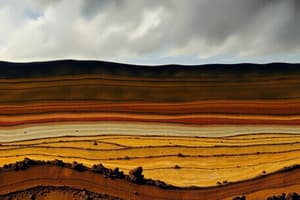Podcast
Questions and Answers
Is soil the top surface of the earth's crust?
Is soil the top surface of the earth's crust?
True (A)
Irish soils are old because they were formed before the last Ice Age.
Irish soils are old because they were formed before the last Ice Age.
False (B)
Soil provides physical support for plant roots.
Soil provides physical support for plant roots.
True (A)
Igneous rock is formed when layers of sediments are compacted over millions of years.
Igneous rock is formed when layers of sediments are compacted over millions of years.
Limestone is formed from shells and other materials containing calcium.
Limestone is formed from shells and other materials containing calcium.
Metamorphic rocks are formed when intense heat or pressure is put on igneous rocks or sedimentary rocks.
Metamorphic rocks are formed when intense heat or pressure is put on igneous rocks or sedimentary rocks.
Physical weathering due to frost can cause rocks to shatter and break.
Physical weathering due to frost can cause rocks to shatter and break.
Hydration is the addition of water to a rock mineral and typically occurs after oxidation where iron oxide is produced.
Hydration is the addition of water to a rock mineral and typically occurs after oxidation where iron oxide is produced.
Living organisms such as plants, animals, and micro-organisms add humus to the soil when they die.
Living organisms such as plants, animals, and micro-organisms add humus to the soil when they die.
Soils developed under trees are generally less acidic.
Soils developed under trees are generally less acidic.
Basin peats are developed in areas of high rainfall with low evaporation.
Basin peats are developed in areas of high rainfall with low evaporation.
Biological decomposition of rocks is mainly caused by the physical weathering from burrowing animals.
Biological decomposition of rocks is mainly caused by the physical weathering from burrowing animals.
Chemical weathering known as hydrolysis changes the physical characteristics but not the chemical characteristics of rock minerals.
Chemical weathering known as hydrolysis changes the physical characteristics but not the chemical characteristics of rock minerals.
Peat is rich in organic matter and is the main material produced from plant remains in the presence of oxygen.
Peat is rich in organic matter and is the main material produced from plant remains in the presence of oxygen.
Climate does not play a significant role in the weathering of rocks.
Climate does not play a significant role in the weathering of rocks.
Flashcards are hidden until you start studying
Study Notes
Soil Formation
- Soil is the top surface of the earth's surface, consisting of mineral and rock particles, organic matter, water, and air.
- Irish soils are young, formed after the last Ice Age.
- Soil provides a medium for crop growth, physical support for plant roots, and a medium for plant and animal remains decomposition, allowing for nutrient recycling.
Types of Rocks
- There are three groups of rocks: igneous, sedimentary, and metamorphic.
- Igneous Rock: formed when magma or lava solidifies after appearing on the earth's surface.
- Sedimentary Rock: formed when layers of sediments are compacted over millions of years, e.g., limestone formed from shells and other calcium-containing materials.
- Metamorphic Rock: formed when intense heat or pressure is applied to igneous rocks or sedimentary rocks, e.g., marble formed from limestone.
Weathering of Rocks
- Physical Weathering: frost causes cracks in rocks, which are filled by water that expands when frozen, causing the rock to shatter and break.
- Physical Weathering: root activity and animal activity (e.g., digging and burrowing) contribute to rock breakdown.
- Chemical Weathering (Hydrolysis): a chemical reaction between water and rock minerals, changing their chemical characteristics and size.
- Biological Decomposition of Rocks: bacteria, fungi, and lichens break down nitrogen and carbon dioxide from the atmosphere, producing acids.
Factors Affecting Soil Formation
- Parent Material: type of rock that soils are formed from, impacting acidity and texture of soil, e.g., limestone is alkaline.
- Topography (Lie of the Land): soil depth is affected by slope, with soils on slopes being thin and holding a good depth of soil in areas below.
- Aspect: direction of the field facing the sun, with south-facing land warming up faster than north-facing land.
- Climate: water contributes to weathering of rocks through frost action, and temperature plays a role in heating and cooling of rocks.
- Living Organisms: plants, animals, and microorganisms add humus to the soil, and microorganisms decompose organic matter, adding nutrients to soils.
Peat and Bogs
- Peat: rich in organic matter, produced from plant remains in the absence of oxygen.
- Three types of bogs: Basin peats, Raised bogs, and Blanket bogs.
- Basin peats: flat bogs developed in lakes and water-logged areas, slightly acidic, and mineral-rich.
- Blanket bogs: developed in areas of high rainfall and low evaporation, very acidic with low fertility.
- Raised bogs: dome-shaped with shallow depressions, water and nutrients supplied from rainfall, and more acidic than blanket bogs.
Studying That Suits You
Use AI to generate personalized quizzes and flashcards to suit your learning preferences.




